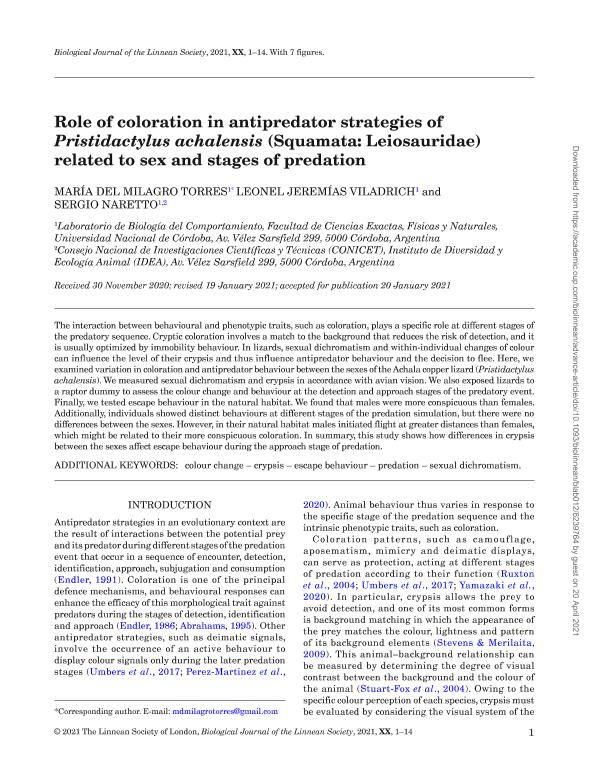Artículo
Role of coloration in antipredator strategies of Pristidactylus achalensis (Squamata: Leiosauridae) related to sex and stages of predation
Fecha de publicación:
20/04/2021
Editorial:
Wiley Blackwell Publishing, Inc
Revista:
Biological Journal of The Linnean Society
ISSN:
0024-4066
Idioma:
Inglés
Tipo de recurso:
Artículo publicado
Clasificación temática:
Resumen
The interaction between behavioural and phenotypic traits, such as coloration, plays a specific role at different stages of the predatory sequence. Cryptic coloration involves a match to the background that reduces the risk of detection, and it is usually optimized by immobility behaviour. In lizards, sexual dichromatism and within-individual changes of colour can influence the level of their crypsis and thus influence antipredator behaviour and the decision to flee. Here, we examined variation in coloration and antipredator behaviour between the sexes of the Achala copper lizard (Pristidactylus achalensis). We measured sexual dichromatism and crypsis in accordance with avian vision. We also exposed lizards to a raptor dummy to assess the colour change and behaviour at the detection and approach stages of the predatory event. Finally, we tested escape behaviour in the natural habitat. We found that males were more conspicuous than females. Additionally, individuals showed distinct behaviours at different stages of the predation simulation, but there were no differences between the sexes. However, in their natural habitat males initiated flight at greater distances than females, which might be related to their more conspicuous coloration. In summary, this study shows how differences in crypsis between the sexes affect escape behaviour during the approach stage of predation.
Palabras clave:
COLOUR CHANGE
,
CRYPSIS
,
ESCAPE BEHAVIOUR
,
PREDATION
,
SEXUAL DICHROMATISM
Archivos asociados
Licencia
Identificadores
Colecciones
Articulos(IDEA)
Articulos de INSTITUTO DE DIVERSIDAD Y ECOLOGIA ANIMAL
Articulos de INSTITUTO DE DIVERSIDAD Y ECOLOGIA ANIMAL
Articulos(INIBIOMA)
Articulos de INST. DE INVEST.EN BIODIVERSIDAD Y MEDIOAMBIENTE
Articulos de INST. DE INVEST.EN BIODIVERSIDAD Y MEDIOAMBIENTE
Citación
Torres, María del Milagro; Viladrich, Leonel Jeremías; Naretto, Sergio; Role of coloration in antipredator strategies of Pristidactylus achalensis (Squamata: Leiosauridae) related to sex and stages of predation; Wiley Blackwell Publishing, Inc; Biological Journal of The Linnean Society; 133; 3; 20-4-2021; 896-909
Compartir
Altmétricas




